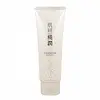What's inside
What's inside
 Key Ingredients
Key Ingredients

No key ingredients
 Benefits
Benefits

 Concerns
Concerns

 Ingredients Side-by-side
Ingredients Side-by-side

Water
Skin ConditioningGlycerin
HumectantGlycylglycine
Butylene Glycol
HumectantHydroxypropyl Starch Phosphate
Cocamidopropyl Betaine
CleansingPEG-400
Emulsion StabilisingDecyl Glucoside
CleansingZinc Lauroyl Aspartate
Tea-Cocoyl Glycinate
CleansingSodium Stearoyl Glutamate
CleansingGlyceryl Stearate
EmollientHyaluronic Acid
HumectantHydroxypropyltrimonium Hyaluronate
Citric Acid
BufferingStearic Acid
CleansingLauric Acid
CleansingPEG-32
HumectantDisodium EDTA
Polyquaternium-7
Hydroxypropyl Methylcellulose
Emulsion StabilisingPolyquaternium-52
Methylparaben
PreservativePropylparaben
PreservativeBHT
AntioxidantWater, Glycerin, Glycylglycine, Butylene Glycol, Hydroxypropyl Starch Phosphate, Cocamidopropyl Betaine, PEG-400, Decyl Glucoside, Zinc Lauroyl Aspartate, Tea-Cocoyl Glycinate, Sodium Stearoyl Glutamate, Glyceryl Stearate, Hyaluronic Acid, Hydroxypropyltrimonium Hyaluronate, Citric Acid, Stearic Acid, Lauric Acid, PEG-32, Disodium EDTA, Polyquaternium-7, Hydroxypropyl Methylcellulose, Polyquaternium-52, Methylparaben, Propylparaben, BHT
Water
Skin ConditioningGlycerin
HumectantPalmitic Acid
EmollientLauric Acid
CleansingPotassium Hydroxide
BufferingStearic Acid
CleansingMyristic Acid
CleansingRice Ferment Filtrate
Skin ConditioningLauramidopropyl Hydroxysultaine
CleansingDisodium EDTA
Polyquaternium-39
Hydrolyzed Rice Protein
Skin ConditioningCyclodextrin
AbsorbentHydrolyzed Rice Extract
Skin ConditioningAlcohol
AntimicrobialLactobacillus/Oryza Sativa Ferment
Skin ConditioningMaltitol
HumectantArginine
MaskingOryza Sativa Bran Extract
Skin ConditioningWater, Glycerin, Palmitic Acid, Lauric Acid, Potassium Hydroxide, Stearic Acid, Myristic Acid, Rice Ferment Filtrate, Lauramidopropyl Hydroxysultaine, Disodium EDTA, Polyquaternium-39, Hydrolyzed Rice Protein, Cyclodextrin, Hydrolyzed Rice Extract, Alcohol, Lactobacillus/Oryza Sativa Ferment, Maltitol, Arginine, Oryza Sativa Bran Extract
 Reviews
Reviews

Ingredients Explained
These ingredients are found in both products.
Ingredients higher up in an ingredient list are typically present in a larger amount.
Disodium EDTA plays a role in making products more stable by aiding other preservatives.
It is a chelating agent, meaning it neutralizes metal ions that may be found in a product.
Disodium EDTA is a salt of edetic acid and is found to be safe in cosmetic ingredients.
Learn more about Disodium EDTAGlycerin is already naturally found in your skin. It helps moisturize and protect your skin.
A study from 2016 found glycerin to be more effective as a humectant than AHAs and hyaluronic acid.
As a humectant, it helps the skin stay hydrated by pulling moisture to your skin. The low molecular weight of glycerin allows it to pull moisture into the deeper layers of your skin.
Hydrated skin improves your skin barrier; Your skin barrier helps protect against irritants and bacteria.
Glycerin has also been found to have antimicrobial and antiviral properties. Due to these properties, glycerin is often used in wound and burn treatments.
In cosmetics, glycerin is usually derived from plants such as soybean or palm. However, it can also be sourced from animals, such as tallow or animal fat.
This ingredient is organic, colorless, odorless, and non-toxic.
Glycerin is the name for this ingredient in American English. British English uses Glycerol/Glycerine.
Learn more about GlycerinLauric Acid is a fatty acid or lipid. About half of fatty acids in coconut oil is lauric acid.
This ingredient helps hydrate and sooth skin. As a humectant, it helps trap moisture. It also aids in cleaning and enhancing the texture of products.
Lauric acid may not be Malassezia folliculitis, or fungal acne, safe.
Learn more about Lauric AcidStearic Acid is a fatty acid. It is an emollient, emulsifier, and texture enhancer.
As an emollient, stearic acid helps soften skin. It aids the skin's protective barrier by preventing water loss. It also provides a gentle cleansing effect without stripping away natural oils.
Stearic acid may also be used to enhance the texture of products. It can add volume and stabilize ingredients such as water and oil. This can help water and oil ingredients from separating.
Sources of stearic acid include animal or vegetable fats/oils such as coconut or shea. It can be naturally found in butter, cocoa butter, shea butter, vegetable fats, and animal tallow.
This ingredient may not be Malassezia folliculitis, or fungal-acne safe.
Learn more about Stearic AcidWater. It's the most common cosmetic ingredient of all. You'll usually see it at the top of ingredient lists, meaning that it makes up the largest part of the product.
So why is it so popular? Water most often acts as a solvent - this means that it helps dissolve other ingredients into the formulation.
You'll also recognize water as that liquid we all need to stay alive. If you see this, drink a glass of water. Stay hydrated!
Learn more about Water